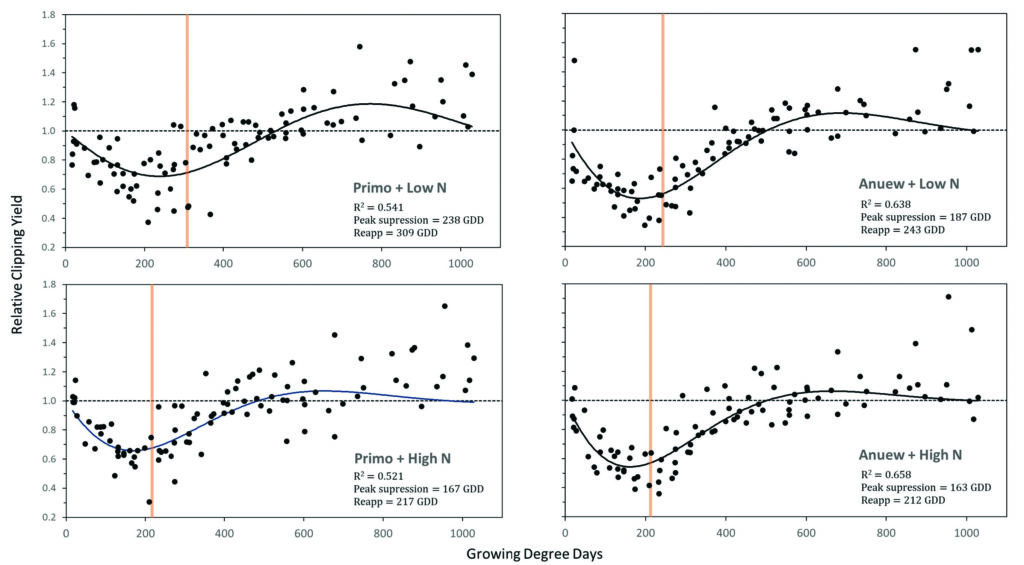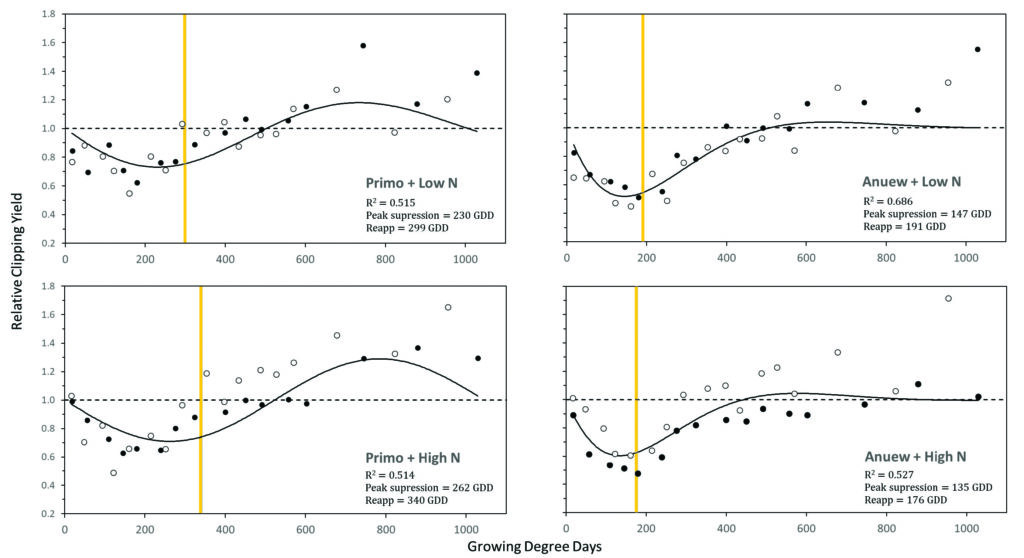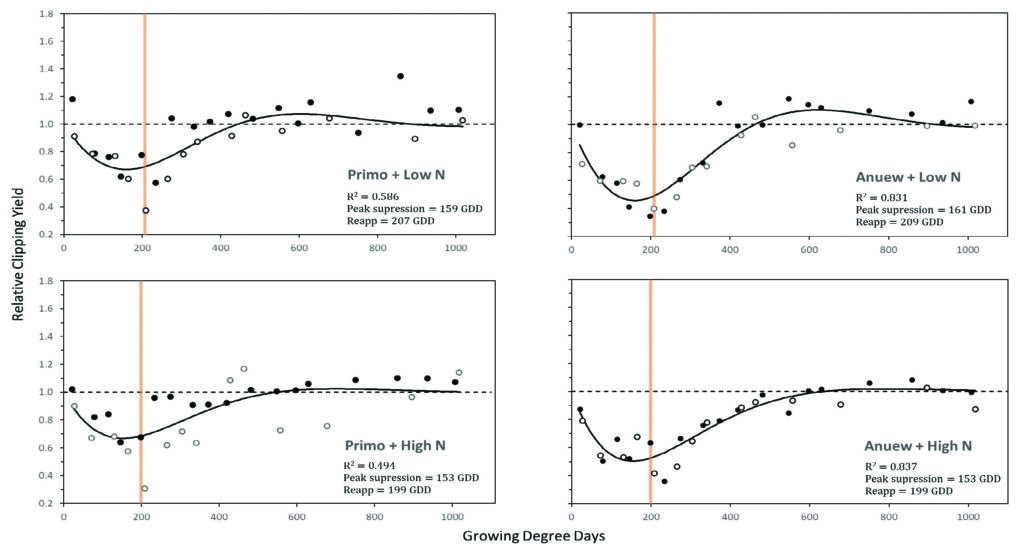Evaluating PGR reapplication on annual bluegrass putting greens
Plant growth regulators (PGR) are typically applied to golf course putting greens on a calendar-based schedule. Recently, growing degree-day (GDD) models for PGR reapplication interval have been developed to provide season-long growth suppression, including models for applications of Primo Maxx 1ME (trinexapac-ethyl, Syngenta) (4) and Trimmit 2SC (paclobutrazol, Syngenta) on creeping bentgrass and hybrid bermudagrass putting greens (8).
No previous research has attempted to develop a GDD model for PGRs on annual bluegrass (ABG) putting greens. Instead, superintendents managing ABG putting greens have relied on GDD models developed for creeping bentgrass as a baseline for reapplication intervals. Thus, developing GDD models for PGR reapplication interval on ABG turf is needed.
The effect of N rate on ABG putting green turf quality, disease susceptibility and playability has been well documented (1, 2 and 9), but little is known about the effect of N rate on PGRs applied to annual bluegrass. Specifically, if the N rate influences the PGR reapplication interval for ABG putting greens greater rates of N may require a more frequent (<GDD) reapplication interval compared to lower rates. Further research is needed to determine if GDD models for PGRs should be adjusted based on N rates.
For annual bluegrass putting greens, our objectives were to develop a growing degree day model for PGR (Primo Maxx and Anuew) application intervals and determine if nitrogen rate influences a growing degree day model.
Materials and Methods
This three-year field trial was initiated in June 2023. The trial is being conducted on a sand-based annual bluegrass research green constructed using the USGA rootzone specifications (10). The research green is managed to simulate conditions found on golf course putting greens in the Pacific Northwest. Pesticides with no plant growth effects (e.g., demethylation inhibitors) were applied preventatively to control common diseases and insect pests.
An onsite weather station was used to measure daily air temperatures, which were used to calculate cumulative GDD using methods (7), with a base temperature of 32 degrees F and the stipulation that if the daily mean temperature is less than the base temperature, then the GDD for that day is set to zero.
Treatment Design
The treatment design for the trial was adapted from previously published research (5 and 8). The experiment was designed as a two-by-two factorial in a randomized complete block design with four replications. Factors include PGR type, either a single application of Primo Maxx 1ME (trinexapac-ethyl, Syngenta) at 0.125 fl. oz. per 1,000 ft² or Anuew (prohexadione-Ca, Nufarm) at 0.05 fl. oz. per 1,000 ft², and N rate, either 0.075 or 0.15 lb. N per 1,000 ft² every seven days throughout the trial period (June through September).
Plot size for the trial is 3 x 10 ft (30 ft²). Plant growth regulator treatments were applied with a CO2-pressured backpack sprayer using a carrier volume of 2.0 gallons per 1,000 ft². Multiple runs of the experiment were conducted each year. In 2023, experimental runs were initiated on June 13, July 13 and Aug. 15. In 2024, applications were made on June 18, July 11 and Aug. 15.
A single application of the PGRs was made to research plots where no previous application of PGRs had been made within those years. Two sets of nontreated control plots were included per replication to improve the accuracy of calculating relative clipping yield (5).
Data Collection
Clipping collection methods were adapted from previous research (8). Clippings were collected three times per week (Monday, Wednesday and Friday) until approximately 600 GDD. At that point, they were collected once per week until the effects of Primo and Anuew were no longer detectable (≈1,000 GDD).
Clipping collection and general plot mowing were done using an electric walk-behind greens mower (eFlex 2120, Toro Company), with the bench height set at 0.110 inches. The entire plot area was mowed six days per week (except Saturday), including when clippings were collected from treated plots. Sand topdressing was withheld from the trial area to prevent contamination in the clipping samples. Any debris was removed from collected clippings before weighing.
Statistical Analysis
Relative clipping yield was compared to GDD using an amplitude-dampened sine wave regression model (5). Data was combined across months (June, July and August) and years (2023 and 2024) for each PGR and N rate combination and analyzed to determine their overall effect on relative growth suppression and reapplication interval.
The nonlinear regression function in SigmaPlot 15 (Systat Software) was used to fit the amplitude-dampened sinewave model defined by Eq. [1].
Relative clipping yield
(g g –1) = 1 + A * e (GDD/D) * sin (2π * GDD/B + π)[1]
Where A is the magnitude of the suppression and rebound growth stages, D is the amplitude decay coefficient, GDD is the cumulative GDD since the last PGR application and B is the period of the model in GDD. In addition, data from each month (June, July and August) was averaged across years (2023 and 2024) for each PGR and N rate combination and analyzed to determine the effect of application timing on relative growth suppression and reapplication interval.

Preliminary Results
All combinations of PGRs (Primo and Anuew) and N rate (0.075 and 0.15 lb. N per 1,000 ft² per week), averaged across months (June, July and August) and years (2023 and 2024), indicated a significant relationship between relative clipping yield and GDD using a sine wave regression model with R² values ranging from 0.521 to 0.685 (Figure 1).



Peak growth suppression for Primo was observed at 238 and 167 GDD for the low and high rate of N, respectively, with predicted reapplication intervals of 309 and 217 GDD. The reapplication interval for Primo, in combination with high rates of N (217 GDD), was similar to previous reports of a GDD reapplication interval of 230 GDD for creeping bentgrass (3). However, when Primo is combined with low rates of N (0.075 lb. N per 1,000 ft²), the reapplication interval appears to be much higher (309 GDD) than previous recommendations or Primo combined with high N.
Differences in peak suppression and reapplication interval between N rates (low and high) combined with Anuew were less dramatic than those observed in Primo treatments. Anuew, combined with high rates of N, resulted in peak suppression at 163 GDD and a reapplication interval of 212 GDD. In contrast, Anuew combined with low N showed peak suppression at 187 GDD and a reapplication interval of 243 GDD (Figure 1). Interestingly, the reapplication interval for Anuew on annual bluegrass was less than the previous recommendations for creeping bentgrass of 280 GDD (3).
A sine wave regression model was also used to look at the relationships between relative clipping yield and GDD for each month (June, July and August; averaged across years) to show nuance in reapplication intervals across a season (Figures 2, 3 and 4).
In June, a few differences in peak suppression or reapplication interval were observed between low and high rates of N for either Primo or Anuew. Still, the data does indicate that Primo has a longer reapplication interval than Anuew (Figure 2).
During July, significant differences in reapplication intervals were observed between the two rates of N for both PGRs, with low rates of N extending the reapplication intervals compared to high N rates (Figure 3). Then, in August, few differences were observed between PGRs or N rates, with reapplication intervals ranging from 199 to 209 GDD (Figure 4).
These results indicate that when the turfgrass is exposed to high levels of abiotic stress (i.e., during late summer; July applications), the reapplication intervals for PGRs combined with low N rates were extended by greater than 130 GDD compared to high N rates. During months when the turfgrass had optimum growing conditions (early summer and early fall; June and August applications, respectively), few differences were observed between PGR types and N rates.
Research Takeaways
- The predicted reapplication interval for Primo Maxx 1ME on annual bluegrass ranged from 309 to 217 GDD for low and high N rates, respectively.
- Primo combined with high N was similar to previous recommendations for bentgrass.
- The predicted reapplication interval for Anuew on annual bluegrass ranged from 243 to 212 GDD for low and high N rates, respectively; both estimates were lower than previous recommendations for bentgrass.
- Trends suggest reapplication intervals for PGR varied by month of application.
- PGRs applied to annual bluegrass under stressful environmental conditions during July resulted in longer reapplication intervals, particularly when combined with low N rates, which increased intervals by greater than 130 GDD.
Chas Schmid, Ph.D., and Alec Kowalewski, Ph.D., Department of Horticulture, Oregon State University. This article was adapted from Schmid, Chas, and Kowalewski, Alec. 2024. Influence of nitrogen rate on growing degree day models for plant growth regulator reapplication interval on annual bluegrass putting greens. 2024 USGA Davis Progress Reports. USGA ID# 2023-15-782, pp. 140-150.
References
- 1. Hempfling, J.A. C.J. Schmid, R. Wang, B.B. Clarke, and J.A. Murphy. 2017. Best management practices effect on anthracnose disease of annual bluegrass. Crop Sci. 57:1-9
- 2. Inguagiato, J.C., J.A. Murphy, and B.B. Clarke. 2008. Anthracnose severity on annual bluegrass influenced by nitrogen fertilization, growth regulators, and verticutting. Crop Sci. 48:1595–1607.
- 3. Kreuser, W.C. 2016. The perils of PGR over-regulation. Golfdom. April. 72(4):30-33.
- 4. Kreuser, W.C., and D.J. Soldat. 2011. A growing degree day model to schedule trinexapac-ethyl applications on Agrostis stolonifera golf greens. Crop Sci. 51:2228-2236.
- 5. Kreuser, W.C., J.R. Young, and M.D. Richardson. 2017. Modeling Performance of Plant Growth Regulators. Agric. Environ. Lett. 2:170001.
- 6. Kreuser, W.C., G.R. Obear, D.J. Michael, and D.J. Soldat. 2018. Growing Degree-Day models predict the performance of Paclobutrazol on bentgrass golf putting greens. Crop. Sci. 58:1402–1408.
- 7. McMaster, G.S., and W.W. Wilhelm. 1997. Growing degree-days: One equation, two interpretations. Agric. For. Meteorol. 87:291-300.
- 8. Reasor, E.H., J.T. Brosnan, J.P. Kerns, W.J. Huchens, D.R. Taylor, J.D. McCurdy, D.J. Soldat, and W.C.
- 9. Schmid, C.J., B.B. Clarke, and J.A. Murphy. 2017. Anthracnose severity as influenced by nitrogen source. Crop Sci. 57:1-8
- 10. USGA. 2018. USGA recommendations for a method of putting green construction. US Golf Assoc., Far Hills, NJ.
Related Articles
How much nitrogen is needed to establish seeded bermudagrass?












